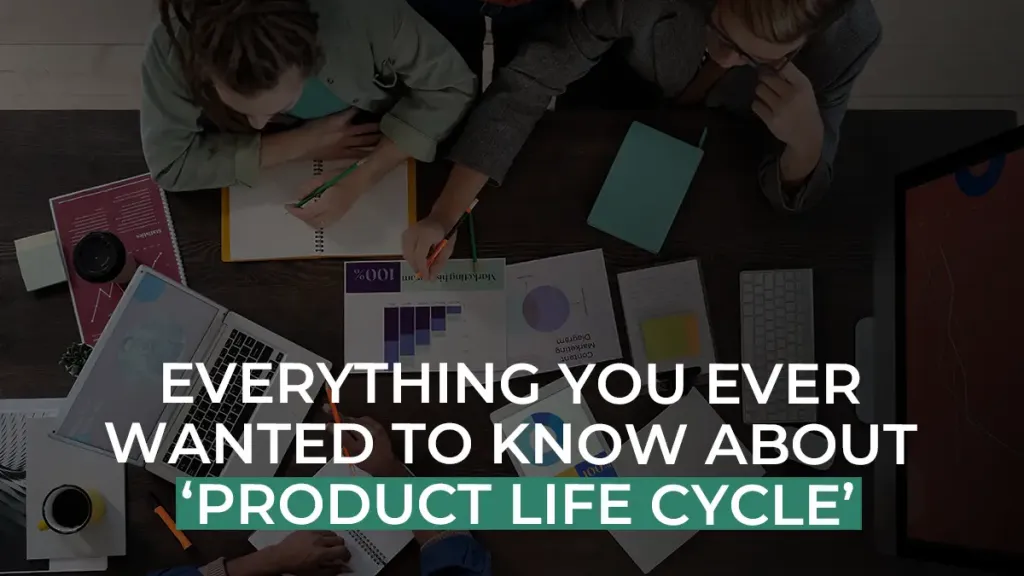Everything You Ever Wanted To Know About ‘Product Life Cycle’ A Comprehensive Guide!

Here's What We've Covered!
We live in a consumerist society and we have for over a 1000 years.
And one of the pillars propping up our consumerism and ‘more is good’ philosophy is, of course, products.
Everywhere you go, look or stay, you are bombarded with products being produced, sold, advertised, exchanged and even discarded.
From the USA to India, Fiji to Greenland, we all rely on products to solve problems, to go about our daily life and to be happy and to make others happy.
Quick! Think of at least 5 products you just cannot live without.
You thought of way more than 5, didn’t you?
But have you ever thought about the journey a particular product you’re so accustomed to (or fond of), goes through, before it reaches your hands, desk or kitchen?
How does anything go from an idea to a prototype to an actual product?
This is the question whose answer can be found by understanding Product Life Cycle.
What is a Product Life Cycle?
Why is it important to understand?
Furthermore, what is Product Life Cycle Management?
Keep reading this comprehensive guide to know everything you ever wanted to know about Product Life Cycle!
What is a Product Life Cycle?
Like people, products too have life cycles.
A Product Life Cycle (PLC) describes the stages a product goes through from when it is first thought of (idea) until it is finally removed from the market (discontinued). PLC is a very important concept in business management in general and marketing in particular because it enables business decision-making to increase advertising, redesign packaging, reduce/raise prices, expand to new markets, etc.
In general, products go through 5 stages in a PLC:
Each stage has its own costs, opportunities, and risks, and therefore requires a different marketing and sales strategy. For example, a new product needs to be explained, while a mature product needs to be differentiated from other similar products that are already in the market.
It’s important to note that some products never move beyond the development phase (read the next section to know more!) while others move through the PLC much faster than others. In addition, not all products reach the final stage of decline (which then usually leads to discontinuation). Some continue to grow and evolve, depending on a number of factors like demand/popularity, social trends, advertising, pricing, etc.
When this happens, a business would extend the PLC using a number of different strategies, either in isolation or in combination. These include:
The stages in a Product Life Cycle
1. Development
Every product begins with an idea. Usually, this idea then goes through a research and development phase where it is either found to be i) feasible and potentially profitable or ii) impractical. In the former case, it is moved on to the next stage while in the latter, it is canceled.
During this stage, costs are accumulating but not offset by revenue. Some high-value products like automobiles and pharmaceuticals require years and large capital investments to develop and test before they can be introduced into the market.
2. Introduction
The introduction phase generally includes a substantial investment in advertising and promotion to make consumers (i.e. the target audience) aware of the product and its benefits. If a market doesn’t already exist, effort is made to create one.
In addition, marketing activities are undertaken, which include:
- Pricing: Skimming pricing to recover development costs before the product attracts more competitors or low-penetration pricing to build market share rapidly
- Branding and Quality: Strategies are identified and implemented
- Distribution: Usually selective until consumers show enthusiasm for the product
In this phase, intellectual property protection (patents, trademarks, etc) is also obtained.
3. Growth
This is the golden age for a product. During the growth phase, demand grows. The firm seeks to increase market share so production is increased and its availability expands to meet increasing demand.
The product quality is maintained. Additional features and distribution channels may be added. Marketing and promotions are aimed at a broad audience. The price usually remains stable as the customers accept the product and the product enjoys increasing demand with little competition.
4. Maturity
As a product matures, it enters its most profitable stage with high unit sales. Distribution becomes more intensive, production and marketing costs fall. Competition also increases as other companies try to emulate its success, often with enhancements or lower prices. To stay competitive, prices decline and promotions emphasize product differentiation. The product may lose market share and begin its decline.
5. Decline
At this stage, due to market saturation, high competition and changing customer needs, sales start to level off and revenues fall.
At this point, the firm can either ‘extend’ (see previous section) or discontinue the product. When they choose the former strategy, they will often rebrand the product as ‘new and improved’.
Product Life Cycle Management
Product Life Cycle Management (PLM) refers to the process of managing the entire PLC and streamlining necessary activities in order to produce a product that outperforms its competitors and remains profitable for as long as possible.
PLM involves managing each stage and element of the PLC including data, people, communications and methodologies. It informs business decision-making, from pricing and advertising/promotions to distribution, expansion and discontinuation.
PLM is critical because it enables firms to:
Product Life Cycle: Two real-world examples from India
Here are two examples of the PLC of famous Indian products, albeit with slight variations.
1. Amul butter
Launched in 1955, butter was one of the first products offered by Amul. Since then, the product has gone through the first 4 stages of the PLC but shows no signs of entering the fifth (decline). Despite competition from local and international brands, Amul continues to remain one of India’s most enduring – and beloved – food brands.
2. Gold Spot (soft drink)
Gold Spot, an orange-flavored carbonated drink was launched in 1952 by Parle Bisleri, becoming one of India’s most popular drink by the mid-1970s. Millions of rupees were spent on advertising and promotions to stay ahead of another very popular drink, the American-owned Coca Cola.
In 1993, the brand’s owner Parle sold Gold Spot to Coca-Cola which had just re-launched in the Indian market. Soon Coca-Cola discontinued Gold Spot in favor of launching its own brand – Fanta.
Some other examples are given in the table below:
Read more: Data-Driven Personalisation_Is this the Future of Digital Marketing
Resent Post
>
How to Find ACCA Jobs Online After Qualifying: Real Portals, Tips & Career Guidance
>
Financial Modelling Classes in Hyderabad: Your Guide to the Best Institutes
>
Still Paying CFA Enrollment Fees? Here’s the Big 2026 Update!
>
How to Use myACCA Like a Pro: Dashboard, Exams, Deadlines & More!
>
Difference Between Financial Accounting and Management Accounting: A Complete Guide



